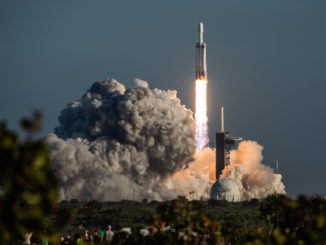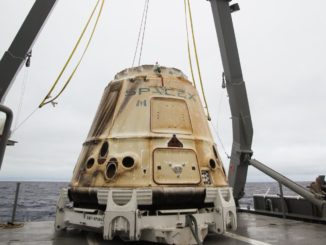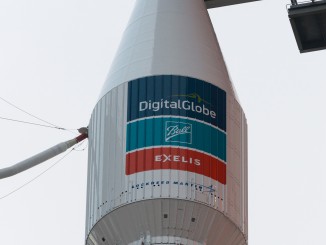EDITOR’S NOTE: All times are “Earth Received Time” when confirmation of events arrive on Earth. The events will occur more than 18 minutes earlier in real time on-board the spacecraft.
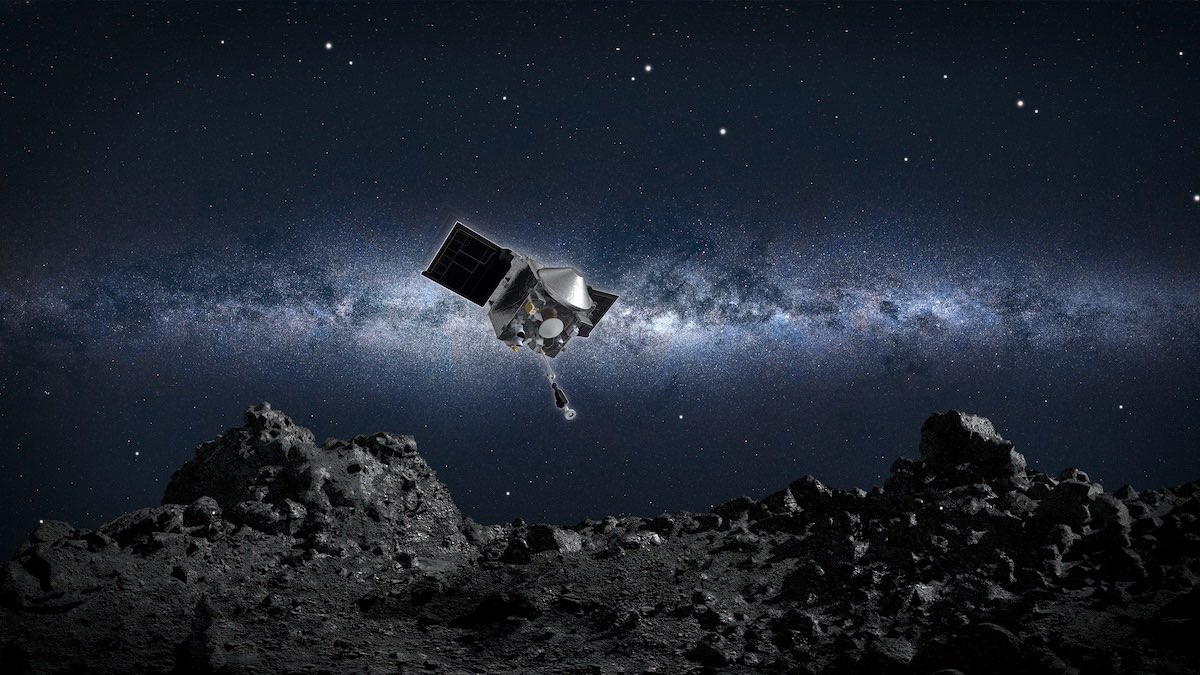
Flying on autopilot more than 200 million miles from Earth, NASA’s OSIRIS-REx spacecraft is on track for a daring touch and go landing on an asteroid Tuesday to grab a sample for return to scientists eager to scan the specimens for clues about the history of the solar system.
The $1 billion mission’s success will come down to a handful of seconds at 6:12 p.m. EDT (2212 GMT) Tuesday, when an arm extended from the OSIRIS-REx spacecraft will contact the gravely surface of asteroid Bennu, release a canister of high-pressure nitrogen gas, and attempt to capture some of the asteroid’s carbon-rich soil.
“Due to the low gravity, we can’t actually land on the surface of Bennu,” said Beth Buck, OSIRIS-REx mission operations program manager at Lockheed Martin, which built and operates the spacecraft for NASA. “So we’ll only be kissing the surface with a short touch and go measured in just seconds.”
If it works, the robotic mission will depart Bennu next year and head back to Earth, where OSIRIS-REx will deploy a re-entry module to plunge into the atmosphere and parachute to a remote U.S. military test range in Utah on Sept. 24, 2023.
The Origins, Spectral Interpretation, Resource Identification, Security, Regolith Explorer is NASA’s first round-trip mission to an asteroid. The space agency selected the mission for development in 2011, and OSIRIS-REx departed Earth on Sept. 8, 2016, with a successful launch from Cape Canaveral aboard a United Launch Alliance Atlas 5 rocket.
The spacecraft swung by Earth in September 2017 for a gravity assist to bend its trajectory toward the orbit of Bennu, which completes one circuit of the sun every 1.2 years. OSIRIS-REx arrived at Bennu in December 2018 and entered orbit around the asteroid, kicking off a nearly two-year campaign to map the asteroid with cameras, mineral-sniffing spectrometers, and a Canadian-built laser to measure its roughness.
OSIRIS-REx also searched for a suitable sampling location, and rehearsed procedures for the touch and go landing.
That culminates in the craft’s descent to Bennu Tuesday, and the goal is to gather at least 2.1 ounces, or 60 grams, of asteroid specimens for return to Earth.
“We all want to take those samples and come home,” said Thomas Zurbuchen, head of NASA’s science mission directorate, in a conference call with reporters Monday.
Scientists and engineers are confident that OSIRIS-REx will execute the touch and go as expected Tuesday. But the spacecraft will be on its own during the most crucial moments of the descent.
Bennu and OSIRIS-REx are currently located some 207 million miles (334 million kilometers) from Earth. At that distance, it takes more than 18 minutes for radio signals traveling at light speed to make a one-way journey from mission control the spacecraft.
OSIRIS-REx will fly autonomously, employing complex navigation software, terrain tracking algorithms, and programmed commands to execute maneuvers to guide itself toward a zone roughly the size of a tennis court on the surface of Bennu.
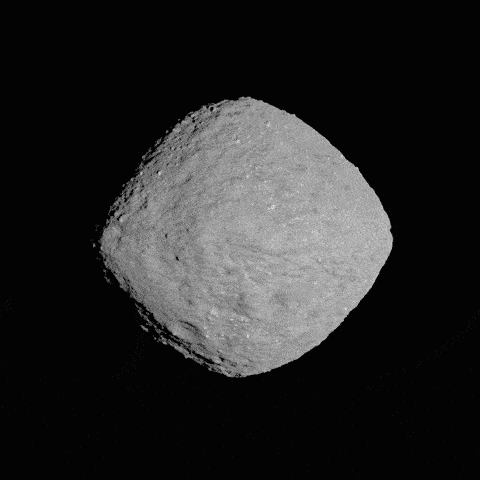
Shaped like a spinning top, Bennu measures around a third of a mile (500 meters) in diameter and rotates once on its axis every 4.3 hours. Named for a bird-like ancient Egyptian deity linked with the sun, creation and rebirth, Bennu follows a path around the sun that intersects Earth’s orbit, and the asteroid makes a relatively close approach to Earth once every six years.
That makes Bennu a potentially hazardous asteroid, and it poses a low threat of eventually hitting Earth. There is a 1-in-2,700 chance of Bennu impacting Earth in the late 2100s.
Bennu was discovered in 1999 by a survey with a ground-based telescope searching for near-Earth asteroids. OSIRIS-REx is the first mission to visit Bennu.
Since arriving at Bennu nearly two years ago, OSIRIS-REx has determined the asteroid is shedding material into space. The mission has also found that Bennu — known as a B-type asteroid — is covered in carbon-rich, water-bearing minerals. The organic material may contain carbon in a form often found in biology or in compounds associated with biology, scientists announced Oct. 8.
“The abundance of carbon-bearing material is a major scientific triumph for the mission,” said Dante Lauretta, OSIRIS-REx principal investigator at the University of Arizona in Tucson. “We are now optimistic that we will collect and return a sample with organic material — a central goal of the OSIRIS-REx mission.”
In a press release accompanying the announcement of the new scientific data earlier this month, NASA described Bennu as a “diamond-shaped pile of rubble floating in space.”
Scientists also said OSIRIS-REx’s targeted touchdown site — dubbed “Nightingale” — also harbors the signature of organic materials, the building blocks of life. The Nightingale location on Bennu’s northern hemisphere is situated inside inside a 460-foot (140-meter) crater, but the area deemed safe for the spacecraft to touch is 52 feet (16 meters) across.
The spacecraft’s solar panels extend more than 20 feet, or 6.2 meters, tip-to-tip.
“It’s kind of a tight fit,” Lauretta said earlier this year.
But scientists expect Nightingale to provide a rich return. Observations from OSIRIS-REx also indicate the material at the touch and go was only recently exposed to the harsh environment of space, meaning the mission could snag pristine samples that have been undisturbed for most of the solar system’s 4.5 billion-year history.
But Bennu offered up some surprises that forced mission managers to replan how OSIRIS-REx will navigate its way to the sampling site.
Bennu turned out to be more rugged than mission planners expected, with large boulders and a lack of expanses with smooth, fine-grained soils that would be perfect for OSIRIS-REx to try and reach during the sampling run.
After seeing Bennu up close, engineers developed upgraded navigation capabilities to help guide OSIRIS-REx the final phase of the descent to the rugged asteroid.
The spacecraft will use a capability called natural feature tracking to take a series of images with a navigation camera to autonomously identify rocks, craters and other landmarks on the asteroid’s surface, yielding data on position and relative velocity. OSIRIS-REx will autonomously will compare the imagery with a topographic map loaded into the computer before the descent.
If the spacecraft detects it is approaching a dangerous area, it can command an abort and back away from Bennu as late as when it is 16 feet, or 5 meters, from the asteroid’s surface. If all goes according to plan, the navigation algorithms will steer OSIRIS-REx to a touch and go site with an accuracy of 23 feet, or 7 meters, three times better than originally planned.
The natural feature tracking algorithms were successfully tested during a rehearsal Aug. 11 that took the spacecraft as close as 131 feet, or 40 meters, from Bennu. The spacecraft’s cameras captured higher-resolution views of the Nightingale sampling location when OSIRIS-REx was flying directly over the site in August, allowing ground teams to update and refine the maps for the natural feature tracking capability before the real sampling attempt.
The August rehearsal followed a similar practice run April 15 that simulated OSIRIS-REx’s decent down to an altitude 213 feet, or 65 meters, before the craft backed away from Bennu.
Officials originally aimed to attempt the sample collection in August, but managers pushed back the event to October to allow more time for teams to complete preparations while contending with remote work and physical distancing requirements to slow the spread of COVID-19.
The spacecraft’s fall toward Bennu will take nearly four-and-a-half hours Tuesday. It’ll go at a much more glacial pace than the seven-minute descents of Mars rovers through the atmosphere of the Red Planet.
“I’m not thinking of this as seven minutes of terror,” Buck said. “This much more of a four-and-a-half hours of mild anxiousness. “We have practiced and rehearsed with the spacecraft … We’ve seen almost all this already and the spacecraft is performing excellently.”
Controllers will oversee the operations from a Lockheed Martin facility near Denver.
Buck said engineers were preparing a final update of navigation parameters Monday for uplink to OSIRIS-REx early Tuesday through NASA’s Deep Space Network, an array of antennas around the world designed to communicate with probes throughout the solar system.
“Then the spacecraft has what it needs for this autonomous operation,” Buck said.
The OSIRIS-REx spacecraft will fire thrusters at around 1:50 p.m. EDT (1750 GMT) to leave a “safe-home orbit” roughly 0.6 miles (1 kilometer) from asteroid Bennu. The burn will change the craft’s velocity relative to the asteroid by less than 0.2 mph, or about 8 centimeters per second, according to Kenneth Getzandanner, OSIRIS-REx’s flight dynamics manager at Goddard.
Bennu’s small size and weak gravity field mean OSIRIS-REx can adjust its trajectory with tiny impulses from its rocket engines.
At around 2:10 p.m. EDT (1810 GMT), OSIRIS-REx will extend its robotic sampling arm — called the Touch And Go Sample Acquisition Mechanism, or TAGSAM. The arm is about 11 feet (3.35 meters) long, with a drum-shaped fixture on the end that resembles an air filter affixed to an antique automobile.
The descent will be slow and methodical. Bennu’s tenuous gravity will pull on the spacecraft at just 10 micro-g, equivalent to ten one-millionths the strength of Earth’s gravity, making the approach more like rendezvous with the space station than landing on another planet.
OSIRIS-REx will turn to the attitude, or orientation, for the final descent to the asteroid at around 5:29 p.m. EDT (2129 GMT), then adjust its two solar array wings to a “Y-wing” configuration beginning at 5:36 p.m. EDT (2136 GMT) to safely position them away from the asteroid’s surface.
The spacecraft’s computer will compute exact times for the descent’s final two rocket burns based on data from the on-board navigation program tracking the locations of landmarks on Bennu’s surface. The guidance system will generate navigation solutions automatically, tweaking the subsequent burn times as needed.
A checkpoint burn at around 5:50 p.m. EDT (2150 GMT) will allow OSIRIS-REx to begin a free fall toward the asteroid.
“At that point, the checkpoint maneuver turns the spacecraft and send OSIRIS-REx down toward the surface,” Getzandanner said. “After the spacecraft crosses about 50 meters (164 feet) in altitude — about 10 minutes after checkpoint — the third and final maneuver, the matchpoint maneuver, slows the descent … and sets up the spacecraft for soft contact on Nightingale.”
The matchpoint burn is scheduled for approximately 6 p.m. EDT (2200 GMT).
OSIRIS-REx will reach Bennu’s surface at a velocity of approximately 0.2 mph — 10 centimeters per second — a fraction of a normal walking pace. The spacecraft will not stay there for long, taking around 10 to 15 seconds for TAGSAM to do its job as the nozzle contacts the asteroid.
A bottle of compressed nitrogen gas will discharge during the touch and go maneuver, scouring up bits of dust and rock from up to 8 inches (20 centimeters) beneath Bennu’s surface, where material should be shielded from wild temperature swings that could damage sensitive organics.
Invented by a Lockheed Martin engineer, the TAGSAM nozzle will trap samples blown away by the pulse of nitrogen and suck them into a collector with a rush of air, similar to a reverse vacuum cleaner. A camera aimed at the collector will record how it works at one frame per second. The imagery, coupled with precise measurements of changes in the spacecraft’s mass in the coming days, will tell engineers how the device performed.
The mechanism can only handle rocks up to three-quarters of an inch — about 2 centimeters — in diameter. That’s about the size of a U.S. nickel.
Mike Moreau, the mission’s flight dynamics system manager at Goddard, compared the dynamics of the arm contacting the asteroid to bouncing on a pogo stick.
After several seconds in contact with Bennu, OSIRIS-REx will fire thrusters again to take off from the asteroid and back into orbit.
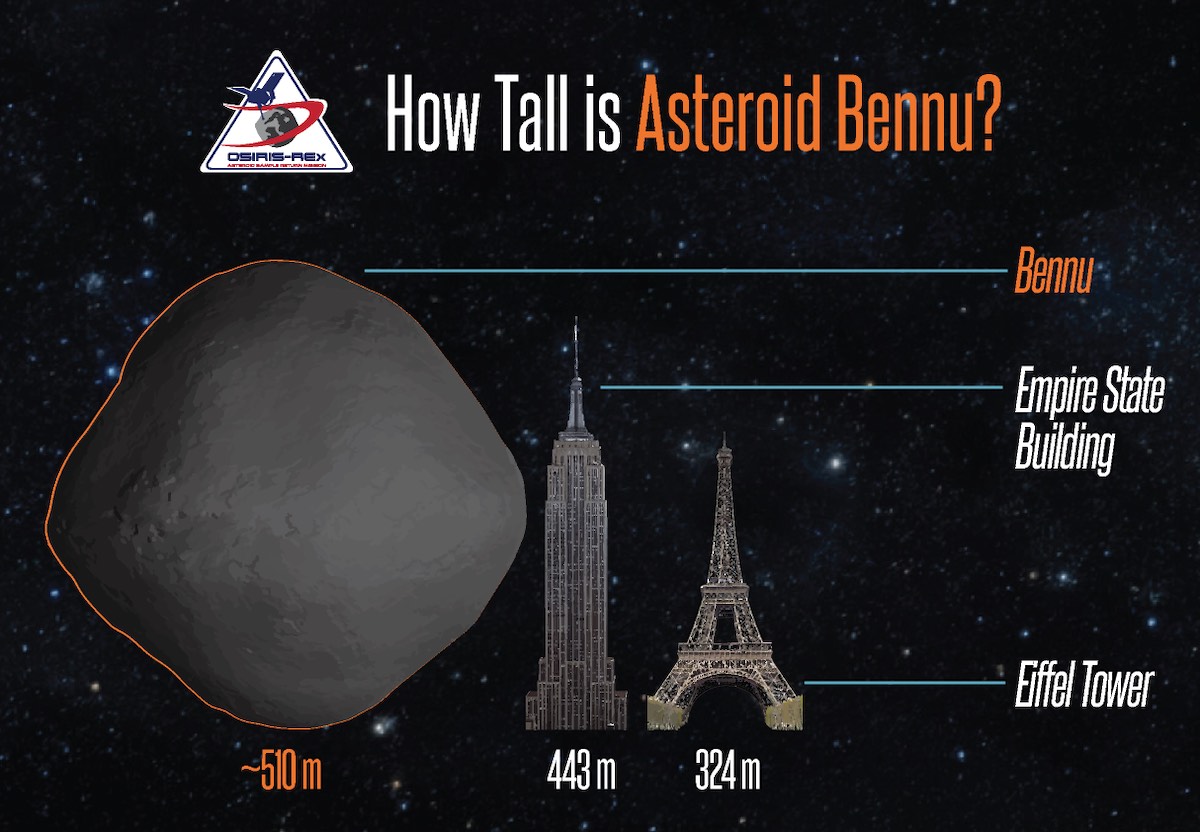
During the most critical phases of the descent, the spacecraft will only send limited telemetry data back to Earth. Later Tuesday night, OSIRIS-REx will reestablish high data rate communications with ground teams, and controllers will be able to fully assess how the spacecraft performed.
The first images from the touch and go will be beamed back to Earth on Wednesday to show how the sampling system worked, and giving an early indication of whether the spacecraft gathered the expected specimens.
On Saturday, controllers are scheduled to command OSIRIS-REx into a spin maneuver to measure its moment of inertia. Engineers will compare the results to a similar maneuver before the sampling run, yielding an estimate of how much mass the spacecraft grabbed from Bennu.
“The requirement is 60 grams,” Lauretta said. “That’s based on the science team, where we’ve looked at all the laboratories across the world that we want to send material to, and how much material do we need to get the information about the organic chemistry, the hydrated minerals, the ages, exposures, all kinds of information about the sample. So the science needs the 60 grams.
“But TAGSAM actually was tested to pick up at least 150 grams (one-third of a pound),” Lauretta said. “And in the best case scenario where the TAGSAM filter is filled up … we might have a kilogram of sample or more.”
“The best outcome would be that we would collect a massive sample,” said Heather Enos, OSIRIS-REx’s deputy principal investigator at the University of Arizona. “We say we have a requirement for 60 grams, or 2 ounces, but we have the capability of collecting up to 2 kilograms. I would love for that capsule to be completely full.”
If NASA is satisfied with the amount of material picked up by OSIRIS-REx, agency leaders could decide Oct. 30 that the mission has met its sample collection requirement. In that case, the spacecraft will continue remote sensing observations of the asteroid before beginning its return to Earth in mid-2021.
Just in case OSIRIS-REx has to abort its touch and go landing — there’s about a 6% chance of a wave-off, officials said — or doesn’t get as much sample as expected, planners have reserved time for a second sampling run as soon as January.
Once they are confident the spacecraft has the asteroid samples, ground controllers will send commands for the TAGSAM arm to place the collection canister inside OSIRIS-REx’s landing capsule. Explosive bolts will sever the TAGSAM head from the craft’s robotic arm, and the capsule’s lid will close over the device for the trip home.
After OSIRIS-REx’s return carrier lands back on Earth, a recovery team will transport the craft to NASA’s Johnson Space Center in Houston, where scientists will open the canister inside a pristine sample curation laboratory and begin studying its contents.
Researchers at Johnson’s astromaterials lab also analyze rocks returned from the moon by the Apollo astronauts.
Enos said scientists hope for asteroid materials that “represent Bennu’s signatures of carbon-rich and hydrated minerals. That would be amazing, and I have every reason to believe that that’s going to be in that sample.”
“In terms of the size distribution, I would hope that we have a couple of different size distributions. I would like tiny grains. I would like a couple almost at the maximum 2 centimeters that we can ingest,” Enos said Monday. “So diversity is key to be able to get the most out of the sample. That is what my money is on tomorrow.”
The team that developed and built the OSIRIS-REx spacecraft took extra measures to ensure the asteroid sample will not be contaminated by organic materials from Earth.
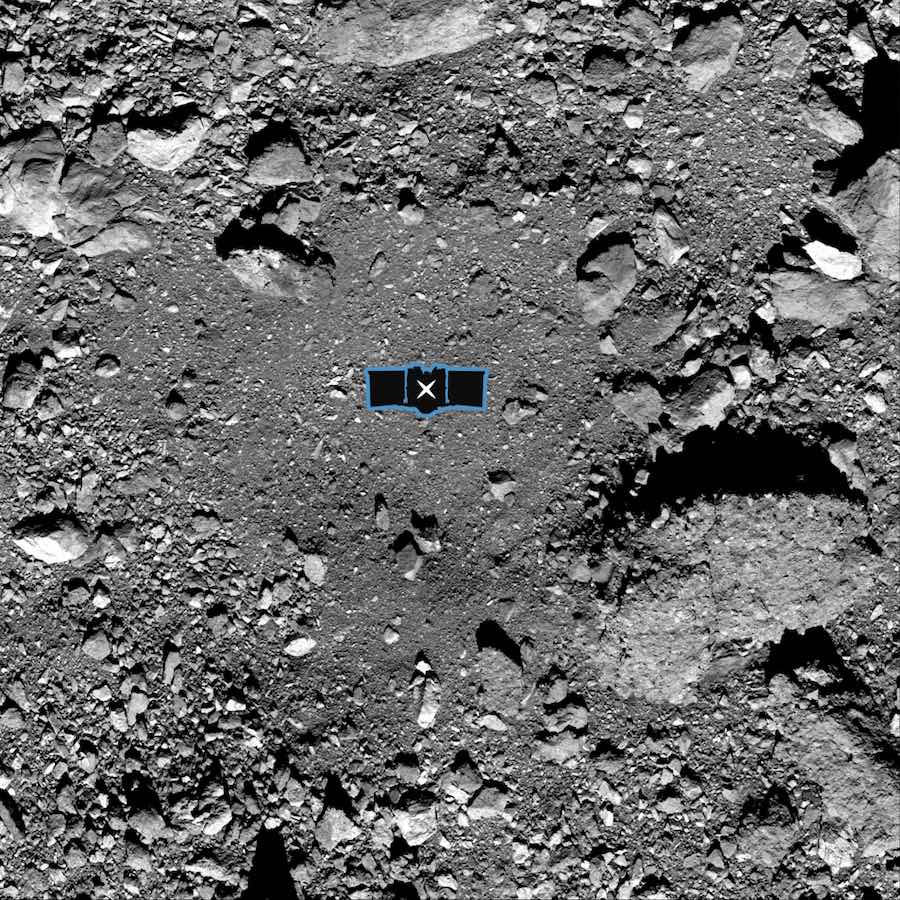
Researchers will use optical and electron microscopes, super-computing labs, and synchrotron accelerators — instruments the size of a large room or a building — in their asteroid sample analysis.
Scientific equipment qualified to fly in space have to operate in extreme temperatures, an airless vacuum, and intense radiation, all while functioning on very little power.
Scientists will attempt to determine the chirality, or handedness, of amino acids and other compounds grabbed from Bennu. Molecules associated with life, such as DNA, have a distinctive orientation. In the case of DNA in organisms on Earth, the double helix always twists in a right-handed direction, and the atoms that make up amino acids in biology are almost always left-handed.
The preference for a left or right orientation among the atoms making up biological molecules makes it easier for chemicals to latch together and build more complex structures.
“Bennu is one of over a million known asteroids in our solar system, and these asteroids are relics of that earliest material that formed the planets in the solar system, and they hold the key information to unlocking how the solar system formed, and how it evolved over time,” said Lori Glaze, director of NASA’s planetary science division.
Data from OSIRIS-REx’s surveys of Bennu show many of the asteroid’s darkest boulders are weaker and more porous than expected. Scientists say most of the boulders on the asteroid are too weak to survive entry into Earth’s atmosphere, so the specimens targeted by OSIRIS-REx could offer a “missing link” because similar rocks are not well represented in meteorite collections.
“Returned samples from Bennu could help us answer some key astrobiology questions, such as how water and organic materials were delivered to Earth, and the role those key ingredients played in the early initiation of life on Earth.”
Another objective of the OSIRIS-REx mission is to characterize the forces pushing on Bennu and gradually changing its orbit. One of the forces is called the Yarkovsky effect, in which thermal emissions from an asteroid can alter its trajectory through the solar system. Solar radiation pressure is another influence on asteroid orbits.
That data will help scientists better predict when asteroids might threaten Earth.
While it is the first U.S. asteroid sample return probe, OSIRIS-REx is not the only spacecraft currently traveling the solar system on a mission to retrieve materials from an asteroid and bring them back to Earth.
Japan’s Hayabusa 2 spacecraft is on course to bring home samples from asteroid Ryugu on Dec. 6, capping a six-year expedition in space. The mission captured bits of rock from two locations on the half-mile-wide (900-meter) asteroid last year.
Like Bennu, Ryugu is an asteroid rich in carbon and organics.
NASA and the Japan Aerospace Exploration Agency have agreed to share Hayabusa 2 and OSIRIS-REx samples with scientists in each country.
“We have an exchange of scientists working on both missions, and of course, we’ll be exchanging portions of each other’s samples so we that we can maximize the science,” Glaze said.
“We believe (JAXA had) a very successful attempt, and they expect to bring back material, but our hope is with OSIRIS-REx, we’ll be collecting significantly more mass of samples, she said. “So between the two of them, we should have an excellent combination of samples to study.”
Email the author.
Follow Stephen Clark on Twitter: @StephenClark1.

